DIPLOMA TRANSPORTATION AND DISTRIBUTION MANAGEMENT.
VerifiedAdded on 2022/11/12
|13
|3341
|6
AI Summary
prebooking
Contribute Materials
Your contribution can guide someone’s learning journey. Share your
documents today.
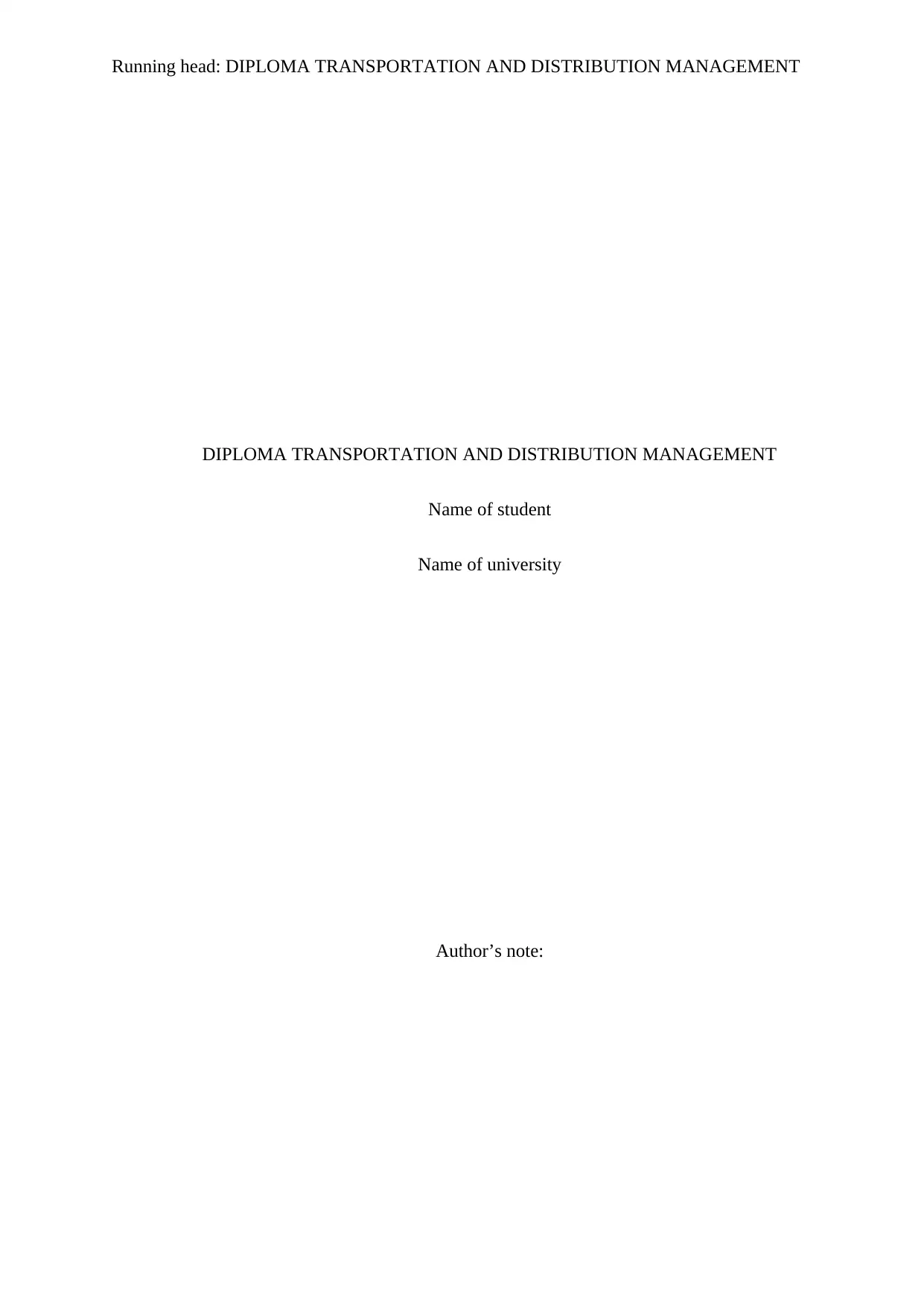
Running head: DIPLOMA TRANSPORTATION AND DISTRIBUTION MANAGEMENT
DIPLOMA TRANSPORTATION AND DISTRIBUTION MANAGEMENT
Name of student
Name of university
Author’s note:
DIPLOMA TRANSPORTATION AND DISTRIBUTION MANAGEMENT
Name of student
Name of university
Author’s note:
Secure Best Marks with AI Grader
Need help grading? Try our AI Grader for instant feedback on your assignments.
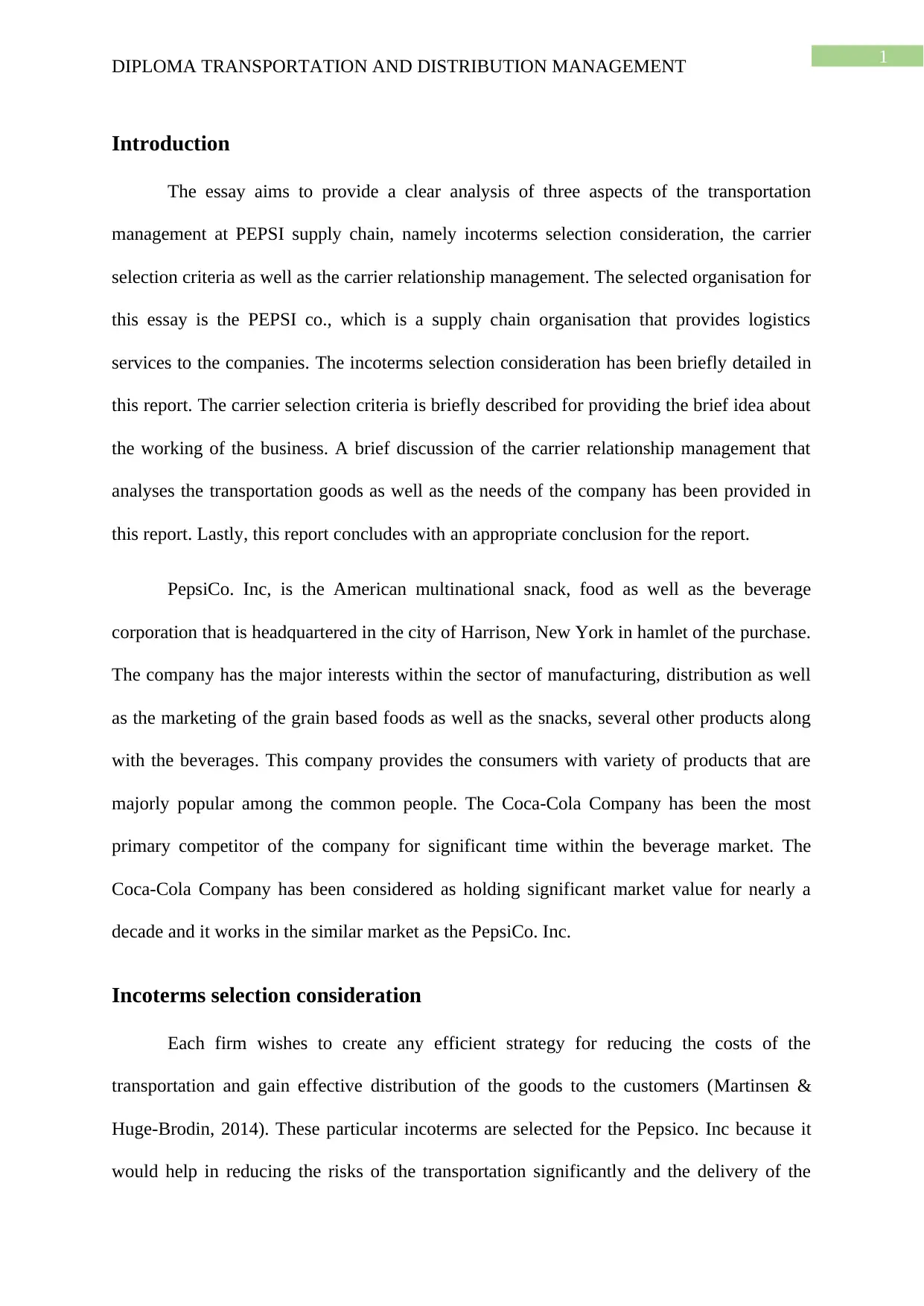
1
DIPLOMA TRANSPORTATION AND DISTRIBUTION MANAGEMENT
Introduction
The essay aims to provide a clear analysis of three aspects of the transportation
management at PEPSI supply chain, namely incoterms selection consideration, the carrier
selection criteria as well as the carrier relationship management. The selected organisation for
this essay is the PEPSI co., which is a supply chain organisation that provides logistics
services to the companies. The incoterms selection consideration has been briefly detailed in
this report. The carrier selection criteria is briefly described for providing the brief idea about
the working of the business. A brief discussion of the carrier relationship management that
analyses the transportation goods as well as the needs of the company has been provided in
this report. Lastly, this report concludes with an appropriate conclusion for the report.
PepsiCo. Inc, is the American multinational snack, food as well as the beverage
corporation that is headquartered in the city of Harrison, New York in hamlet of the purchase.
The company has the major interests within the sector of manufacturing, distribution as well
as the marketing of the grain based foods as well as the snacks, several other products along
with the beverages. This company provides the consumers with variety of products that are
majorly popular among the common people. The Coca-Cola Company has been the most
primary competitor of the company for significant time within the beverage market. The
Coca-Cola Company has been considered as holding significant market value for nearly a
decade and it works in the similar market as the PepsiCo. Inc.
Incoterms selection consideration
Each firm wishes to create any efficient strategy for reducing the costs of the
transportation and gain effective distribution of the goods to the customers (Martinsen &
Huge-Brodin, 2014). These particular incoterms are selected for the Pepsico. Inc because it
would help in reducing the risks of the transportation significantly and the delivery of the
DIPLOMA TRANSPORTATION AND DISTRIBUTION MANAGEMENT
Introduction
The essay aims to provide a clear analysis of three aspects of the transportation
management at PEPSI supply chain, namely incoterms selection consideration, the carrier
selection criteria as well as the carrier relationship management. The selected organisation for
this essay is the PEPSI co., which is a supply chain organisation that provides logistics
services to the companies. The incoterms selection consideration has been briefly detailed in
this report. The carrier selection criteria is briefly described for providing the brief idea about
the working of the business. A brief discussion of the carrier relationship management that
analyses the transportation goods as well as the needs of the company has been provided in
this report. Lastly, this report concludes with an appropriate conclusion for the report.
PepsiCo. Inc, is the American multinational snack, food as well as the beverage
corporation that is headquartered in the city of Harrison, New York in hamlet of the purchase.
The company has the major interests within the sector of manufacturing, distribution as well
as the marketing of the grain based foods as well as the snacks, several other products along
with the beverages. This company provides the consumers with variety of products that are
majorly popular among the common people. The Coca-Cola Company has been the most
primary competitor of the company for significant time within the beverage market. The
Coca-Cola Company has been considered as holding significant market value for nearly a
decade and it works in the similar market as the PepsiCo. Inc.
Incoterms selection consideration
Each firm wishes to create any efficient strategy for reducing the costs of the
transportation and gain effective distribution of the goods to the customers (Martinsen &
Huge-Brodin, 2014). These particular incoterms are selected for the Pepsico. Inc because it
would help in reducing the risks of the transportation significantly and the delivery of the
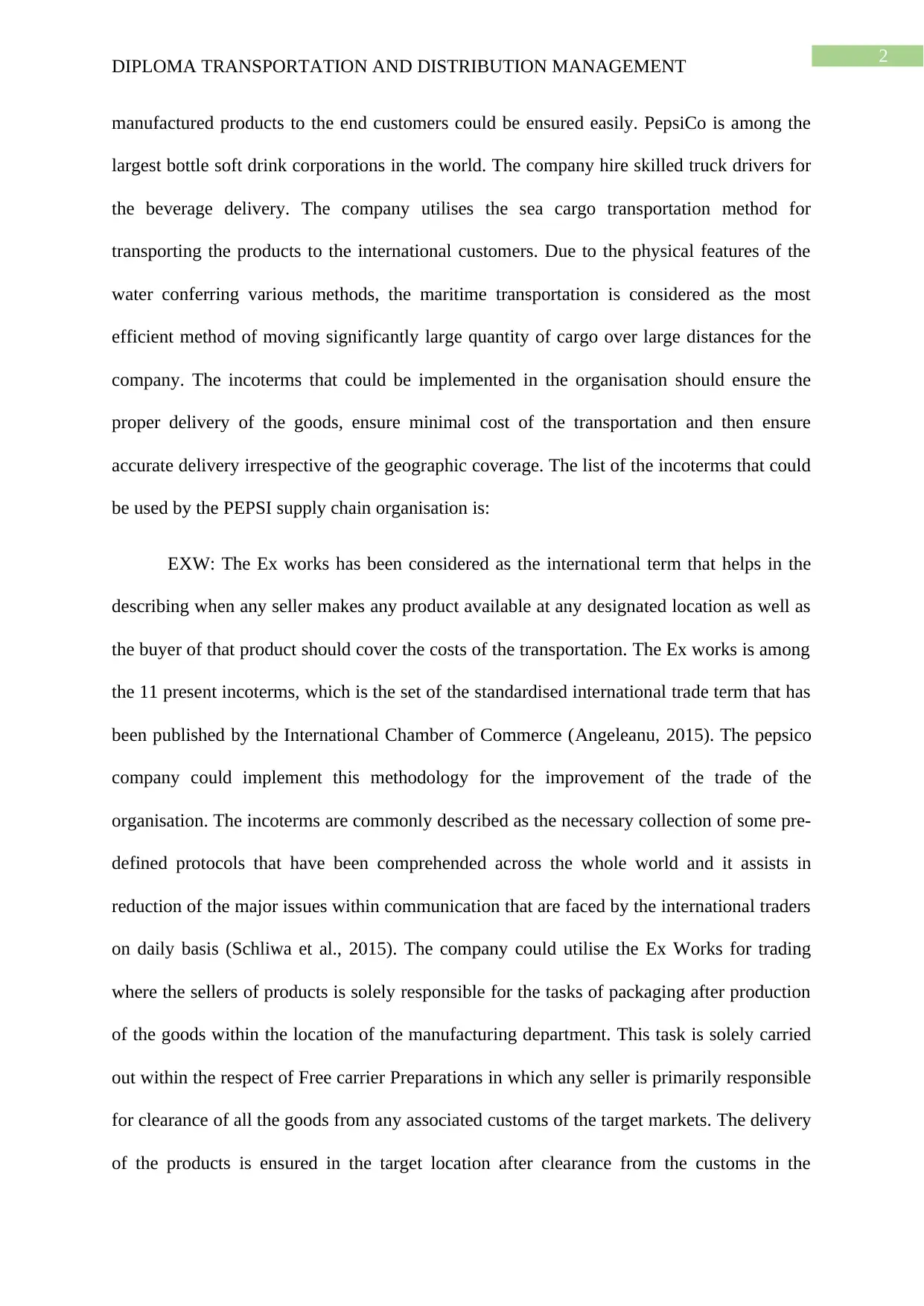
2
DIPLOMA TRANSPORTATION AND DISTRIBUTION MANAGEMENT
manufactured products to the end customers could be ensured easily. PepsiCo is among the
largest bottle soft drink corporations in the world. The company hire skilled truck drivers for
the beverage delivery. The company utilises the sea cargo transportation method for
transporting the products to the international customers. Due to the physical features of the
water conferring various methods, the maritime transportation is considered as the most
efficient method of moving significantly large quantity of cargo over large distances for the
company. The incoterms that could be implemented in the organisation should ensure the
proper delivery of the goods, ensure minimal cost of the transportation and then ensure
accurate delivery irrespective of the geographic coverage. The list of the incoterms that could
be used by the PEPSI supply chain organisation is:
EXW: The Ex works has been considered as the international term that helps in the
describing when any seller makes any product available at any designated location as well as
the buyer of that product should cover the costs of the transportation. The Ex works is among
the 11 present incoterms, which is the set of the standardised international trade term that has
been published by the International Chamber of Commerce (Angeleanu, 2015). The pepsico
company could implement this methodology for the improvement of the trade of the
organisation. The incoterms are commonly described as the necessary collection of some pre-
defined protocols that have been comprehended across the whole world and it assists in
reduction of the major issues within communication that are faced by the international traders
on daily basis (Schliwa et al., 2015). The company could utilise the Ex Works for trading
where the sellers of products is solely responsible for the tasks of packaging after production
of the goods within the location of the manufacturing department. This task is solely carried
out within the respect of Free carrier Preparations in which any seller is primarily responsible
for clearance of all the goods from any associated customs of the target markets. The delivery
of the products is ensured in the target location after clearance from the customs in the
DIPLOMA TRANSPORTATION AND DISTRIBUTION MANAGEMENT
manufactured products to the end customers could be ensured easily. PepsiCo is among the
largest bottle soft drink corporations in the world. The company hire skilled truck drivers for
the beverage delivery. The company utilises the sea cargo transportation method for
transporting the products to the international customers. Due to the physical features of the
water conferring various methods, the maritime transportation is considered as the most
efficient method of moving significantly large quantity of cargo over large distances for the
company. The incoterms that could be implemented in the organisation should ensure the
proper delivery of the goods, ensure minimal cost of the transportation and then ensure
accurate delivery irrespective of the geographic coverage. The list of the incoterms that could
be used by the PEPSI supply chain organisation is:
EXW: The Ex works has been considered as the international term that helps in the
describing when any seller makes any product available at any designated location as well as
the buyer of that product should cover the costs of the transportation. The Ex works is among
the 11 present incoterms, which is the set of the standardised international trade term that has
been published by the International Chamber of Commerce (Angeleanu, 2015). The pepsico
company could implement this methodology for the improvement of the trade of the
organisation. The incoterms are commonly described as the necessary collection of some pre-
defined protocols that have been comprehended across the whole world and it assists in
reduction of the major issues within communication that are faced by the international traders
on daily basis (Schliwa et al., 2015). The company could utilise the Ex Works for trading
where the sellers of products is solely responsible for the tasks of packaging after production
of the goods within the location of the manufacturing department. This task is solely carried
out within the respect of Free carrier Preparations in which any seller is primarily responsible
for clearance of all the goods from any associated customs of the target markets. The delivery
of the products is ensured in the target location after clearance from the customs in the
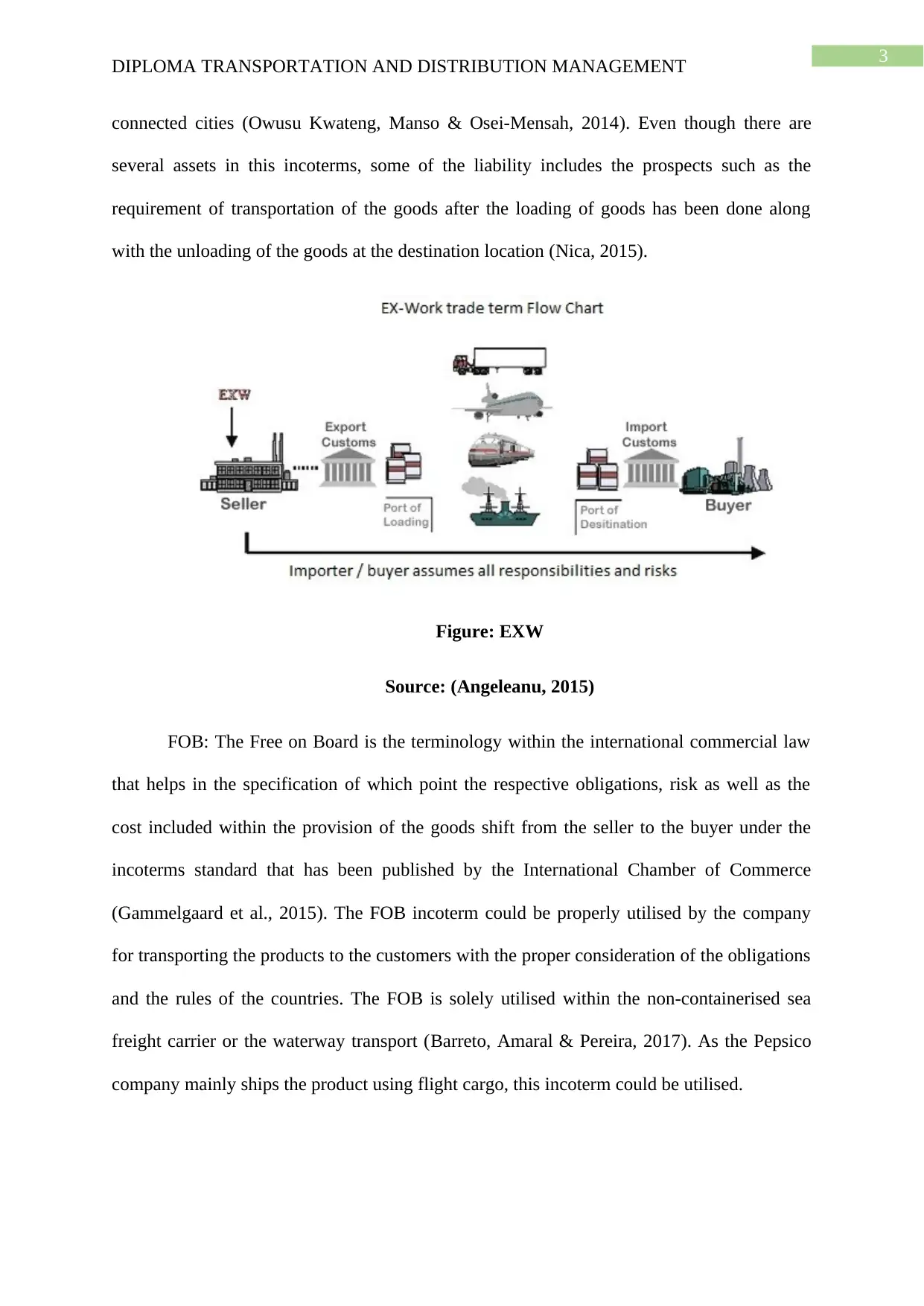
3
DIPLOMA TRANSPORTATION AND DISTRIBUTION MANAGEMENT
connected cities (Owusu Kwateng, Manso & Osei-Mensah, 2014). Even though there are
several assets in this incoterms, some of the liability includes the prospects such as the
requirement of transportation of the goods after the loading of goods has been done along
with the unloading of the goods at the destination location (Nica, 2015).
Figure: EXW
Source: (Angeleanu, 2015)
FOB: The Free on Board is the terminology within the international commercial law
that helps in the specification of which point the respective obligations, risk as well as the
cost included within the provision of the goods shift from the seller to the buyer under the
incoterms standard that has been published by the International Chamber of Commerce
(Gammelgaard et al., 2015). The FOB incoterm could be properly utilised by the company
for transporting the products to the customers with the proper consideration of the obligations
and the rules of the countries. The FOB is solely utilised within the non-containerised sea
freight carrier or the waterway transport (Barreto, Amaral & Pereira, 2017). As the Pepsico
company mainly ships the product using flight cargo, this incoterm could be utilised.
DIPLOMA TRANSPORTATION AND DISTRIBUTION MANAGEMENT
connected cities (Owusu Kwateng, Manso & Osei-Mensah, 2014). Even though there are
several assets in this incoterms, some of the liability includes the prospects such as the
requirement of transportation of the goods after the loading of goods has been done along
with the unloading of the goods at the destination location (Nica, 2015).
Figure: EXW
Source: (Angeleanu, 2015)
FOB: The Free on Board is the terminology within the international commercial law
that helps in the specification of which point the respective obligations, risk as well as the
cost included within the provision of the goods shift from the seller to the buyer under the
incoterms standard that has been published by the International Chamber of Commerce
(Gammelgaard et al., 2015). The FOB incoterm could be properly utilised by the company
for transporting the products to the customers with the proper consideration of the obligations
and the rules of the countries. The FOB is solely utilised within the non-containerised sea
freight carrier or the waterway transport (Barreto, Amaral & Pereira, 2017). As the Pepsico
company mainly ships the product using flight cargo, this incoterm could be utilised.
Secure Best Marks with AI Grader
Need help grading? Try our AI Grader for instant feedback on your assignments.

4
DIPLOMA TRANSPORTATION AND DISTRIBUTION MANAGEMENT
Figure: FOB
Source: (Barreto, Amaral & Pereira, 2017)
CIF: Insurance, Cost and the freight: this modality is significantly equivalent to the
CFR, except that the costs of insurance are generated by exporter. The exporter of the
company should deliver the goods abroad the ship, at port of the embarkation, with the
insurance paid as well as the freight. The duty of exporter ceases when all the products is
offloaded from ship at port of the destination. When all the products of the PepsiCo company
has been unloaded from the cargo ship, the exporter does not have any duty left. This
particular modality could be utilised for the sea as well as the internal waterway
transportation by the organisation (Evangelista, 2014).
DIPLOMA TRANSPORTATION AND DISTRIBUTION MANAGEMENT
Figure: FOB
Source: (Barreto, Amaral & Pereira, 2017)
CIF: Insurance, Cost and the freight: this modality is significantly equivalent to the
CFR, except that the costs of insurance are generated by exporter. The exporter of the
company should deliver the goods abroad the ship, at port of the embarkation, with the
insurance paid as well as the freight. The duty of exporter ceases when all the products is
offloaded from ship at port of the destination. When all the products of the PepsiCo company
has been unloaded from the cargo ship, the exporter does not have any duty left. This
particular modality could be utilised for the sea as well as the internal waterway
transportation by the organisation (Evangelista, 2014).
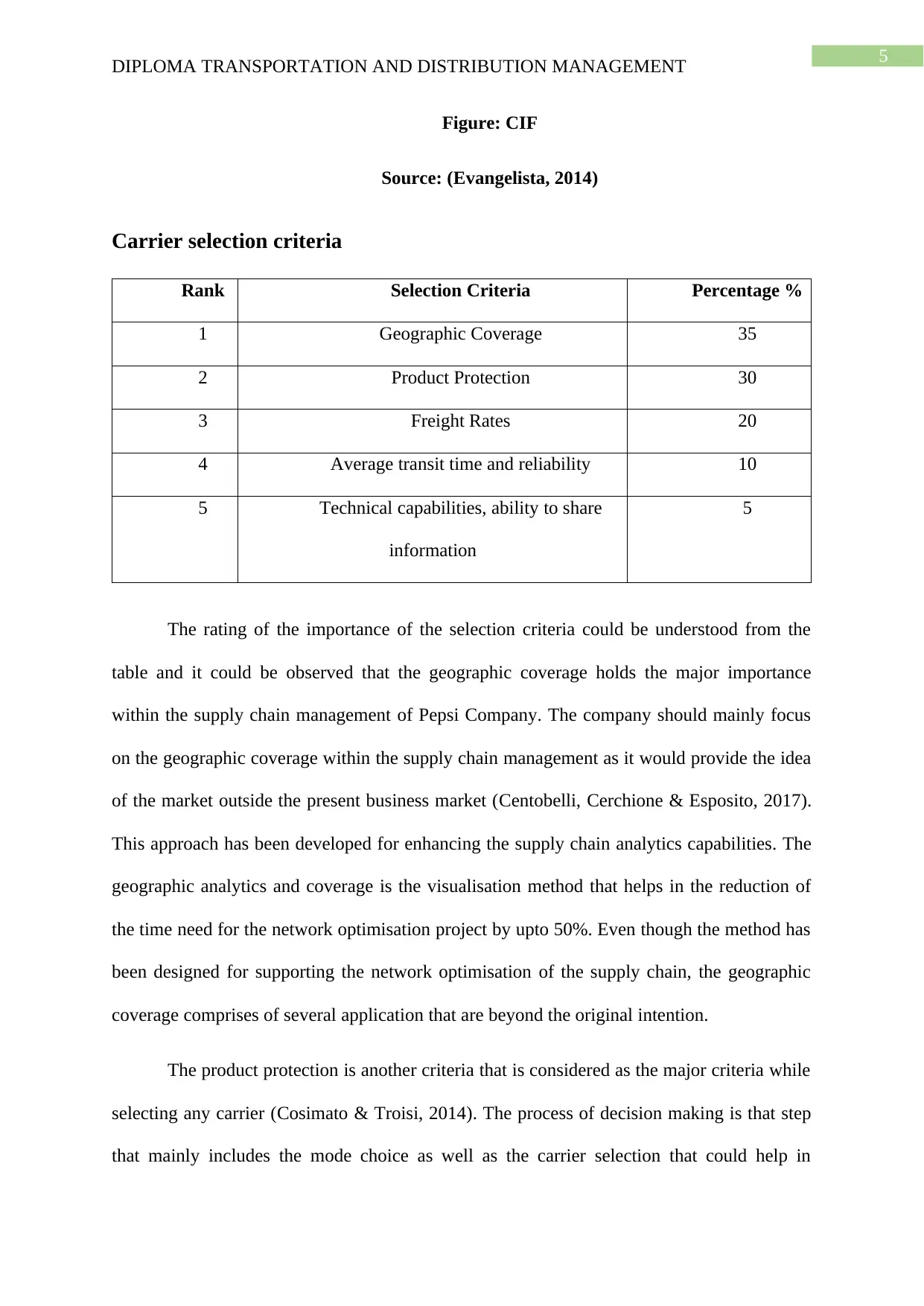
5
DIPLOMA TRANSPORTATION AND DISTRIBUTION MANAGEMENT
Figure: CIF
Source: (Evangelista, 2014)
Carrier selection criteria
Rank Selection Criteria Percentage %
1 Geographic Coverage 35
2 Product Protection 30
3 Freight Rates 20
4 Average transit time and reliability 10
5 Technical capabilities, ability to share
information
5
The rating of the importance of the selection criteria could be understood from the
table and it could be observed that the geographic coverage holds the major importance
within the supply chain management of Pepsi Company. The company should mainly focus
on the geographic coverage within the supply chain management as it would provide the idea
of the market outside the present business market (Centobelli, Cerchione & Esposito, 2017).
This approach has been developed for enhancing the supply chain analytics capabilities. The
geographic analytics and coverage is the visualisation method that helps in the reduction of
the time need for the network optimisation project by upto 50%. Even though the method has
been designed for supporting the network optimisation of the supply chain, the geographic
coverage comprises of several application that are beyond the original intention.
The product protection is another criteria that is considered as the major criteria while
selecting any carrier (Cosimato & Troisi, 2014). The process of decision making is that step
that mainly includes the mode choice as well as the carrier selection that could help in
DIPLOMA TRANSPORTATION AND DISTRIBUTION MANAGEMENT
Figure: CIF
Source: (Evangelista, 2014)
Carrier selection criteria
Rank Selection Criteria Percentage %
1 Geographic Coverage 35
2 Product Protection 30
3 Freight Rates 20
4 Average transit time and reliability 10
5 Technical capabilities, ability to share
information
5
The rating of the importance of the selection criteria could be understood from the
table and it could be observed that the geographic coverage holds the major importance
within the supply chain management of Pepsi Company. The company should mainly focus
on the geographic coverage within the supply chain management as it would provide the idea
of the market outside the present business market (Centobelli, Cerchione & Esposito, 2017).
This approach has been developed for enhancing the supply chain analytics capabilities. The
geographic analytics and coverage is the visualisation method that helps in the reduction of
the time need for the network optimisation project by upto 50%. Even though the method has
been designed for supporting the network optimisation of the supply chain, the geographic
coverage comprises of several application that are beyond the original intention.
The product protection is another criteria that is considered as the major criteria while
selecting any carrier (Cosimato & Troisi, 2014). The process of decision making is that step
that mainly includes the mode choice as well as the carrier selection that could help in
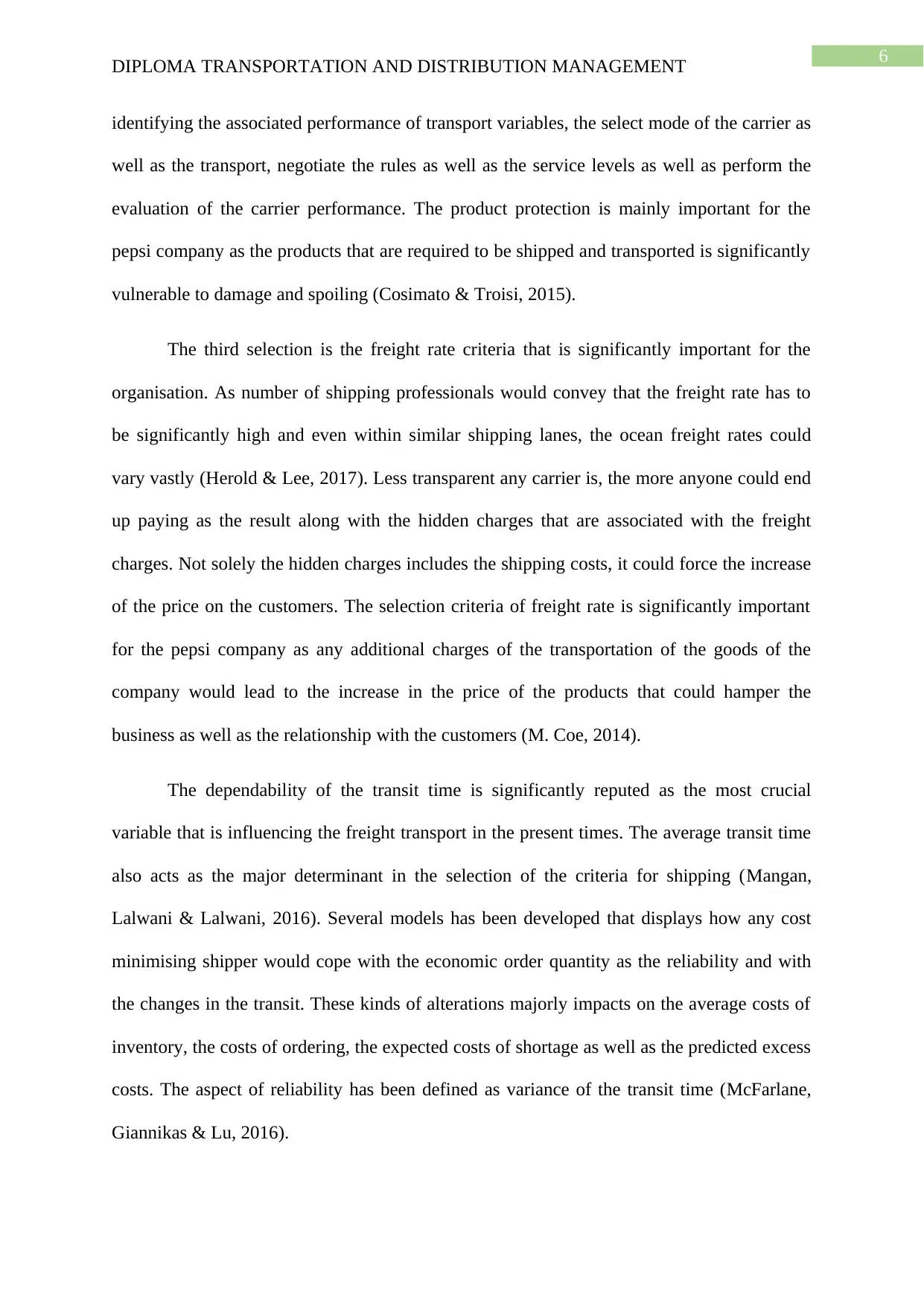
6
DIPLOMA TRANSPORTATION AND DISTRIBUTION MANAGEMENT
identifying the associated performance of transport variables, the select mode of the carrier as
well as the transport, negotiate the rules as well as the service levels as well as perform the
evaluation of the carrier performance. The product protection is mainly important for the
pepsi company as the products that are required to be shipped and transported is significantly
vulnerable to damage and spoiling (Cosimato & Troisi, 2015).
The third selection is the freight rate criteria that is significantly important for the
organisation. As number of shipping professionals would convey that the freight rate has to
be significantly high and even within similar shipping lanes, the ocean freight rates could
vary vastly (Herold & Lee, 2017). Less transparent any carrier is, the more anyone could end
up paying as the result along with the hidden charges that are associated with the freight
charges. Not solely the hidden charges includes the shipping costs, it could force the increase
of the price on the customers. The selection criteria of freight rate is significantly important
for the pepsi company as any additional charges of the transportation of the goods of the
company would lead to the increase in the price of the products that could hamper the
business as well as the relationship with the customers (M. Coe, 2014).
The dependability of the transit time is significantly reputed as the most crucial
variable that is influencing the freight transport in the present times. The average transit time
also acts as the major determinant in the selection of the criteria for shipping (Mangan,
Lalwani & Lalwani, 2016). Several models has been developed that displays how any cost
minimising shipper would cope with the economic order quantity as the reliability and with
the changes in the transit. These kinds of alterations majorly impacts on the average costs of
inventory, the costs of ordering, the expected costs of shortage as well as the predicted excess
costs. The aspect of reliability has been defined as variance of the transit time (McFarlane,
Giannikas & Lu, 2016).
DIPLOMA TRANSPORTATION AND DISTRIBUTION MANAGEMENT
identifying the associated performance of transport variables, the select mode of the carrier as
well as the transport, negotiate the rules as well as the service levels as well as perform the
evaluation of the carrier performance. The product protection is mainly important for the
pepsi company as the products that are required to be shipped and transported is significantly
vulnerable to damage and spoiling (Cosimato & Troisi, 2015).
The third selection is the freight rate criteria that is significantly important for the
organisation. As number of shipping professionals would convey that the freight rate has to
be significantly high and even within similar shipping lanes, the ocean freight rates could
vary vastly (Herold & Lee, 2017). Less transparent any carrier is, the more anyone could end
up paying as the result along with the hidden charges that are associated with the freight
charges. Not solely the hidden charges includes the shipping costs, it could force the increase
of the price on the customers. The selection criteria of freight rate is significantly important
for the pepsi company as any additional charges of the transportation of the goods of the
company would lead to the increase in the price of the products that could hamper the
business as well as the relationship with the customers (M. Coe, 2014).
The dependability of the transit time is significantly reputed as the most crucial
variable that is influencing the freight transport in the present times. The average transit time
also acts as the major determinant in the selection of the criteria for shipping (Mangan,
Lalwani & Lalwani, 2016). Several models has been developed that displays how any cost
minimising shipper would cope with the economic order quantity as the reliability and with
the changes in the transit. These kinds of alterations majorly impacts on the average costs of
inventory, the costs of ordering, the expected costs of shortage as well as the predicted excess
costs. The aspect of reliability has been defined as variance of the transit time (McFarlane,
Giannikas & Lu, 2016).
Paraphrase This Document
Need a fresh take? Get an instant paraphrase of this document with our AI Paraphraser
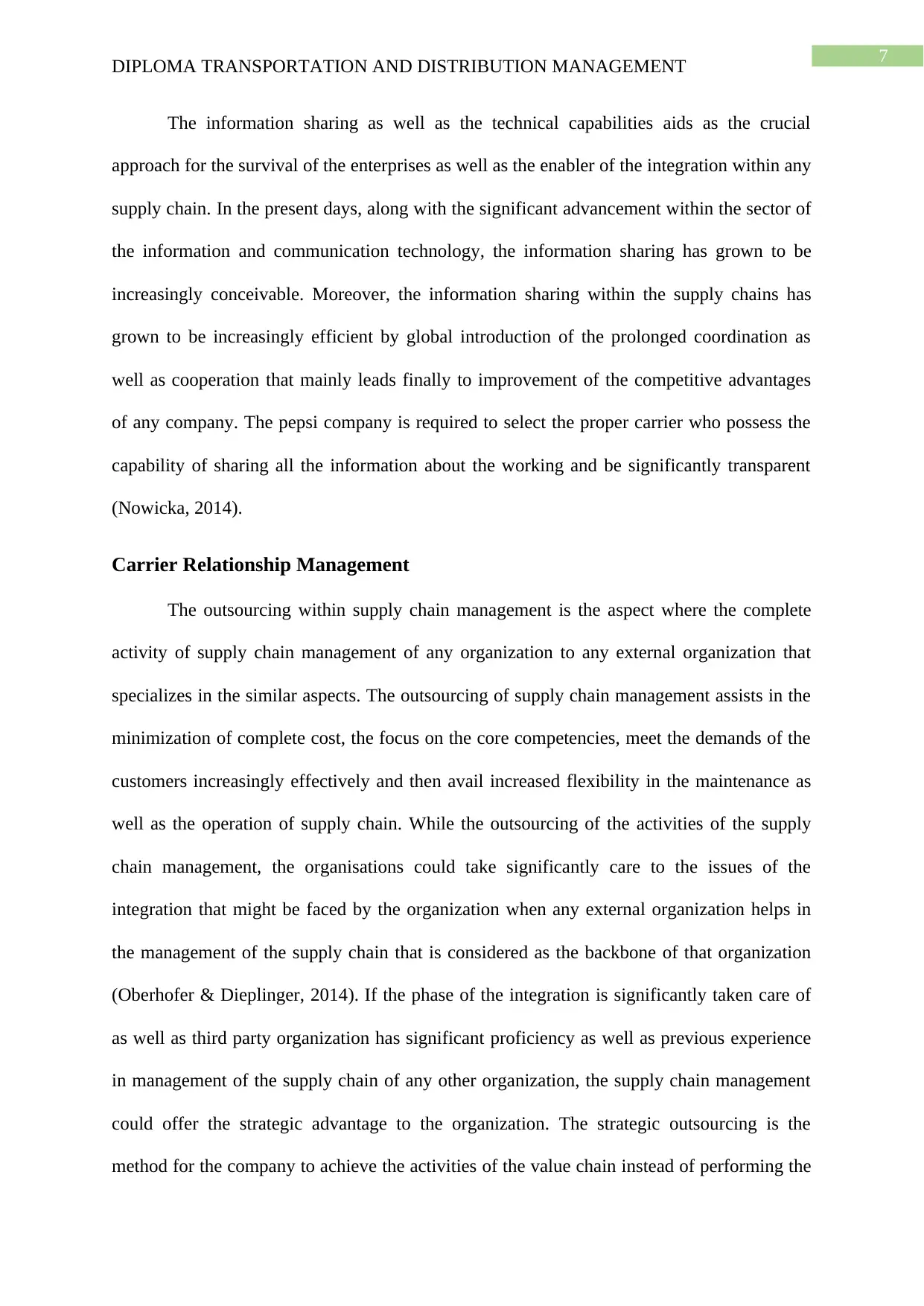
7
DIPLOMA TRANSPORTATION AND DISTRIBUTION MANAGEMENT
The information sharing as well as the technical capabilities aids as the crucial
approach for the survival of the enterprises as well as the enabler of the integration within any
supply chain. In the present days, along with the significant advancement within the sector of
the information and communication technology, the information sharing has grown to be
increasingly conceivable. Moreover, the information sharing within the supply chains has
grown to be increasingly efficient by global introduction of the prolonged coordination as
well as cooperation that mainly leads finally to improvement of the competitive advantages
of any company. The pepsi company is required to select the proper carrier who possess the
capability of sharing all the information about the working and be significantly transparent
(Nowicka, 2014).
Carrier Relationship Management
The outsourcing within supply chain management is the aspect where the complete
activity of supply chain management of any organization to any external organization that
specializes in the similar aspects. The outsourcing of supply chain management assists in the
minimization of complete cost, the focus on the core competencies, meet the demands of the
customers increasingly effectively and then avail increased flexibility in the maintenance as
well as the operation of supply chain. While the outsourcing of the activities of the supply
chain management, the organisations could take significantly care to the issues of the
integration that might be faced by the organization when any external organization helps in
the management of the supply chain that is considered as the backbone of that organization
(Oberhofer & Dieplinger, 2014). If the phase of the integration is significantly taken care of
as well as third party organization has significant proficiency as well as previous experience
in management of the supply chain of any other organization, the supply chain management
could offer the strategic advantage to the organization. The strategic outsourcing is the
method for the company to achieve the activities of the value chain instead of performing the
DIPLOMA TRANSPORTATION AND DISTRIBUTION MANAGEMENT
The information sharing as well as the technical capabilities aids as the crucial
approach for the survival of the enterprises as well as the enabler of the integration within any
supply chain. In the present days, along with the significant advancement within the sector of
the information and communication technology, the information sharing has grown to be
increasingly conceivable. Moreover, the information sharing within the supply chains has
grown to be increasingly efficient by global introduction of the prolonged coordination as
well as cooperation that mainly leads finally to improvement of the competitive advantages
of any company. The pepsi company is required to select the proper carrier who possess the
capability of sharing all the information about the working and be significantly transparent
(Nowicka, 2014).
Carrier Relationship Management
The outsourcing within supply chain management is the aspect where the complete
activity of supply chain management of any organization to any external organization that
specializes in the similar aspects. The outsourcing of supply chain management assists in the
minimization of complete cost, the focus on the core competencies, meet the demands of the
customers increasingly effectively and then avail increased flexibility in the maintenance as
well as the operation of supply chain. While the outsourcing of the activities of the supply
chain management, the organisations could take significantly care to the issues of the
integration that might be faced by the organization when any external organization helps in
the management of the supply chain that is considered as the backbone of that organization
(Oberhofer & Dieplinger, 2014). If the phase of the integration is significantly taken care of
as well as third party organization has significant proficiency as well as previous experience
in management of the supply chain of any other organization, the supply chain management
could offer the strategic advantage to the organization. The strategic outsourcing is the
method for the company to achieve the activities of the value chain instead of performing the
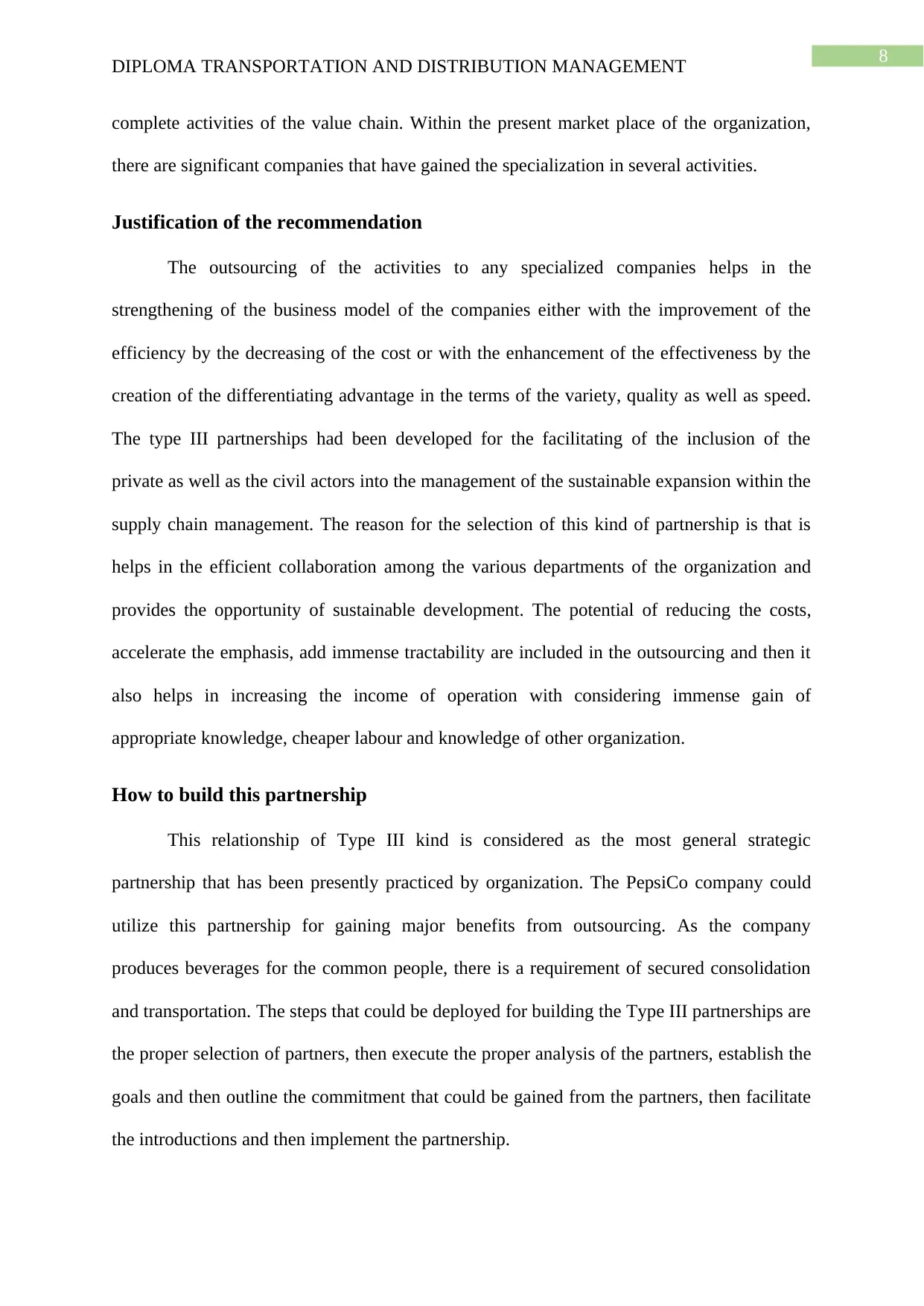
8
DIPLOMA TRANSPORTATION AND DISTRIBUTION MANAGEMENT
complete activities of the value chain. Within the present market place of the organization,
there are significant companies that have gained the specialization in several activities.
Justification of the recommendation
The outsourcing of the activities to any specialized companies helps in the
strengthening of the business model of the companies either with the improvement of the
efficiency by the decreasing of the cost or with the enhancement of the effectiveness by the
creation of the differentiating advantage in the terms of the variety, quality as well as speed.
The type III partnerships had been developed for the facilitating of the inclusion of the
private as well as the civil actors into the management of the sustainable expansion within the
supply chain management. The reason for the selection of this kind of partnership is that is
helps in the efficient collaboration among the various departments of the organization and
provides the opportunity of sustainable development. The potential of reducing the costs,
accelerate the emphasis, add immense tractability are included in the outsourcing and then it
also helps in increasing the income of operation with considering immense gain of
appropriate knowledge, cheaper labour and knowledge of other organization.
How to build this partnership
This relationship of Type III kind is considered as the most general strategic
partnership that has been presently practiced by organization. The PepsiCo company could
utilize this partnership for gaining major benefits from outsourcing. As the company
produces beverages for the common people, there is a requirement of secured consolidation
and transportation. The steps that could be deployed for building the Type III partnerships are
the proper selection of partners, then execute the proper analysis of the partners, establish the
goals and then outline the commitment that could be gained from the partners, then facilitate
the introductions and then implement the partnership.
DIPLOMA TRANSPORTATION AND DISTRIBUTION MANAGEMENT
complete activities of the value chain. Within the present market place of the organization,
there are significant companies that have gained the specialization in several activities.
Justification of the recommendation
The outsourcing of the activities to any specialized companies helps in the
strengthening of the business model of the companies either with the improvement of the
efficiency by the decreasing of the cost or with the enhancement of the effectiveness by the
creation of the differentiating advantage in the terms of the variety, quality as well as speed.
The type III partnerships had been developed for the facilitating of the inclusion of the
private as well as the civil actors into the management of the sustainable expansion within the
supply chain management. The reason for the selection of this kind of partnership is that is
helps in the efficient collaboration among the various departments of the organization and
provides the opportunity of sustainable development. The potential of reducing the costs,
accelerate the emphasis, add immense tractability are included in the outsourcing and then it
also helps in increasing the income of operation with considering immense gain of
appropriate knowledge, cheaper labour and knowledge of other organization.
How to build this partnership
This relationship of Type III kind is considered as the most general strategic
partnership that has been presently practiced by organization. The PepsiCo company could
utilize this partnership for gaining major benefits from outsourcing. As the company
produces beverages for the common people, there is a requirement of secured consolidation
and transportation. The steps that could be deployed for building the Type III partnerships are
the proper selection of partners, then execute the proper analysis of the partners, establish the
goals and then outline the commitment that could be gained from the partners, then facilitate
the introductions and then implement the partnership.
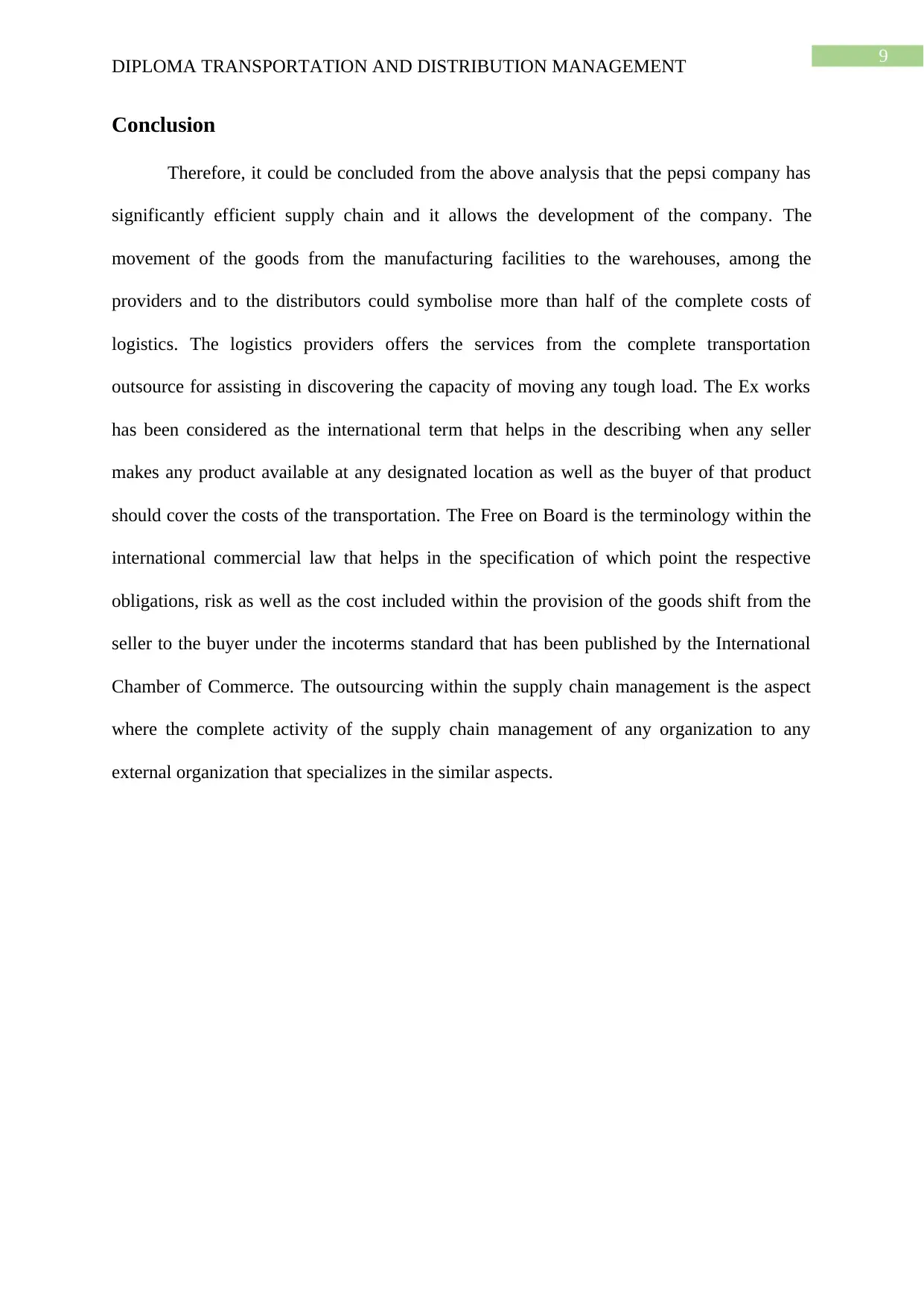
9
DIPLOMA TRANSPORTATION AND DISTRIBUTION MANAGEMENT
Conclusion
Therefore, it could be concluded from the above analysis that the pepsi company has
significantly efficient supply chain and it allows the development of the company. The
movement of the goods from the manufacturing facilities to the warehouses, among the
providers and to the distributors could symbolise more than half of the complete costs of
logistics. The logistics providers offers the services from the complete transportation
outsource for assisting in discovering the capacity of moving any tough load. The Ex works
has been considered as the international term that helps in the describing when any seller
makes any product available at any designated location as well as the buyer of that product
should cover the costs of the transportation. The Free on Board is the terminology within the
international commercial law that helps in the specification of which point the respective
obligations, risk as well as the cost included within the provision of the goods shift from the
seller to the buyer under the incoterms standard that has been published by the International
Chamber of Commerce. The outsourcing within the supply chain management is the aspect
where the complete activity of the supply chain management of any organization to any
external organization that specializes in the similar aspects.
DIPLOMA TRANSPORTATION AND DISTRIBUTION MANAGEMENT
Conclusion
Therefore, it could be concluded from the above analysis that the pepsi company has
significantly efficient supply chain and it allows the development of the company. The
movement of the goods from the manufacturing facilities to the warehouses, among the
providers and to the distributors could symbolise more than half of the complete costs of
logistics. The logistics providers offers the services from the complete transportation
outsource for assisting in discovering the capacity of moving any tough load. The Ex works
has been considered as the international term that helps in the describing when any seller
makes any product available at any designated location as well as the buyer of that product
should cover the costs of the transportation. The Free on Board is the terminology within the
international commercial law that helps in the specification of which point the respective
obligations, risk as well as the cost included within the provision of the goods shift from the
seller to the buyer under the incoterms standard that has been published by the International
Chamber of Commerce. The outsourcing within the supply chain management is the aspect
where the complete activity of the supply chain management of any organization to any
external organization that specializes in the similar aspects.
Secure Best Marks with AI Grader
Need help grading? Try our AI Grader for instant feedback on your assignments.

10
DIPLOMA TRANSPORTATION AND DISTRIBUTION MANAGEMENT
References
Angeleanu, A. (2015). New technology trends and their transformative impact on logistics
and supply chain processes. International Journal of Economic Practices and
Theories, 5(5), 413-419.
Barreto, L., Amaral, A., & Pereira, T. (2017). Industry 4.0 implications in logistics: an
overview. Procedia Manufacturing, 13, 1245-1252.
Centobelli, P., Cerchione, R., & Esposito, E. (2017). Environmental sustainability in the
service industry of transportation and logistics service providers: Systematic literature
review and research directions. Transportation Research Part D: Transport and
Environment, 53, 454-470.
Cosimato, S., & Troisi, O. (2014, August). The influence of green innovation in logistics
competitiveness and sustainability. The PEPSIcase study. In Toulon-Verona
Conference" Excellence in Services".
Cosimato, S., & Troisi, O. (2015). Green supply chain management: Practices and tools for
logistics competitiveness and sustainability. The PEPSIcase study. The TQM
Journal, 27(2), 256-276.
Evangelista, P. (2014). Environmental sustainability practices in the transport and logistics
service industry: An exploratory case study investigation. Research in Transportation
Business & Management, 12, 63-72.
Gammelgaard, B., Prockl, G., Andreasen, P. H., Schramm, H. J., Wieland, A., Maalouf,
M., ... & Roussat, C. (2015). Humanitarian logistics: the role of logistics service
providers. International Journal of Physical Distribution & Logistics Management.
DIPLOMA TRANSPORTATION AND DISTRIBUTION MANAGEMENT
References
Angeleanu, A. (2015). New technology trends and their transformative impact on logistics
and supply chain processes. International Journal of Economic Practices and
Theories, 5(5), 413-419.
Barreto, L., Amaral, A., & Pereira, T. (2017). Industry 4.0 implications in logistics: an
overview. Procedia Manufacturing, 13, 1245-1252.
Centobelli, P., Cerchione, R., & Esposito, E. (2017). Environmental sustainability in the
service industry of transportation and logistics service providers: Systematic literature
review and research directions. Transportation Research Part D: Transport and
Environment, 53, 454-470.
Cosimato, S., & Troisi, O. (2014, August). The influence of green innovation in logistics
competitiveness and sustainability. The PEPSIcase study. In Toulon-Verona
Conference" Excellence in Services".
Cosimato, S., & Troisi, O. (2015). Green supply chain management: Practices and tools for
logistics competitiveness and sustainability. The PEPSIcase study. The TQM
Journal, 27(2), 256-276.
Evangelista, P. (2014). Environmental sustainability practices in the transport and logistics
service industry: An exploratory case study investigation. Research in Transportation
Business & Management, 12, 63-72.
Gammelgaard, B., Prockl, G., Andreasen, P. H., Schramm, H. J., Wieland, A., Maalouf,
M., ... & Roussat, C. (2015). Humanitarian logistics: the role of logistics service
providers. International Journal of Physical Distribution & Logistics Management.
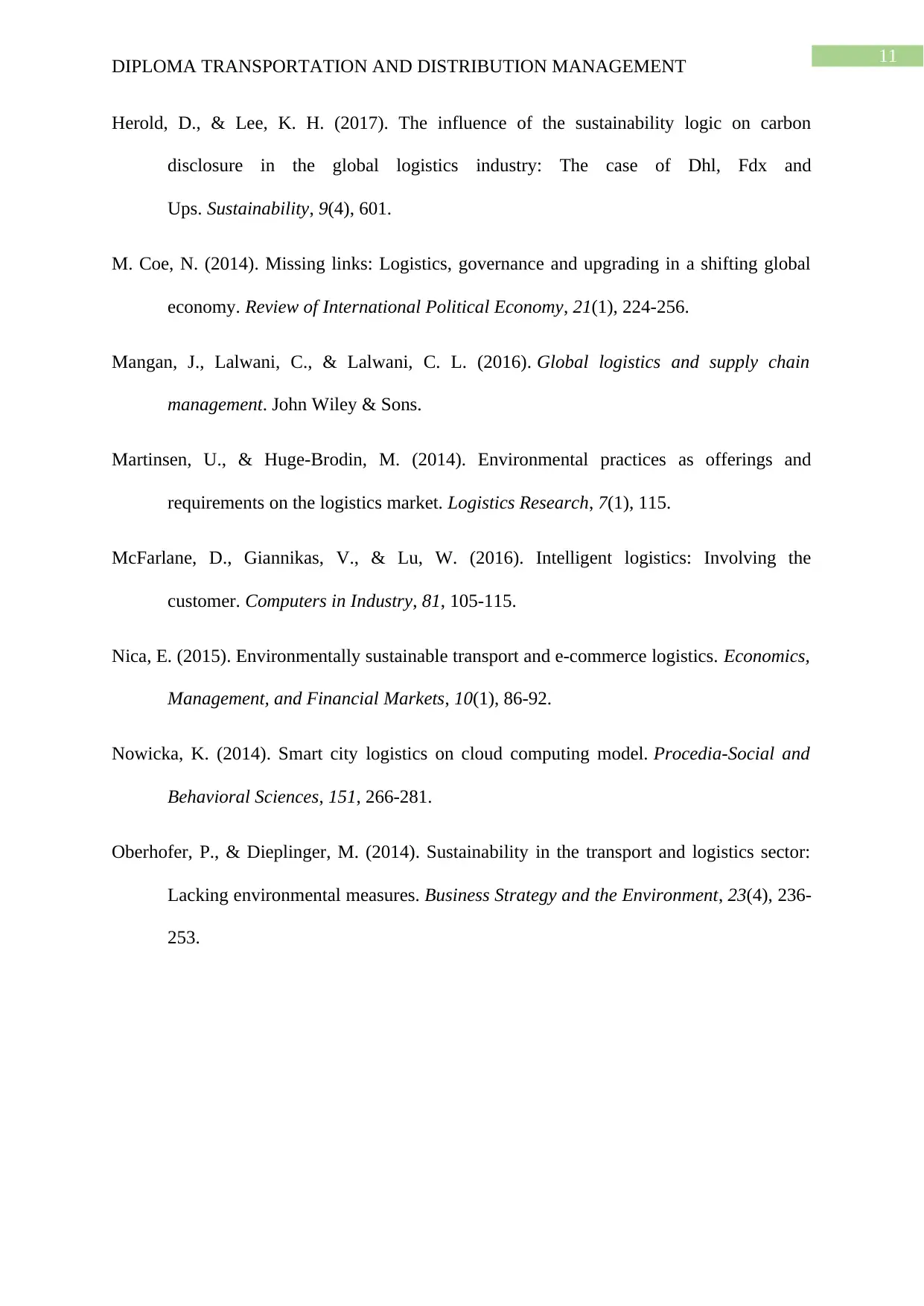
11
DIPLOMA TRANSPORTATION AND DISTRIBUTION MANAGEMENT
Herold, D., & Lee, K. H. (2017). The influence of the sustainability logic on carbon
disclosure in the global logistics industry: The case of Dhl, Fdx and
Ups. Sustainability, 9(4), 601.
M. Coe, N. (2014). Missing links: Logistics, governance and upgrading in a shifting global
economy. Review of International Political Economy, 21(1), 224-256.
Mangan, J., Lalwani, C., & Lalwani, C. L. (2016). Global logistics and supply chain
management. John Wiley & Sons.
Martinsen, U., & Huge-Brodin, M. (2014). Environmental practices as offerings and
requirements on the logistics market. Logistics Research, 7(1), 115.
McFarlane, D., Giannikas, V., & Lu, W. (2016). Intelligent logistics: Involving the
customer. Computers in Industry, 81, 105-115.
Nica, E. (2015). Environmentally sustainable transport and e-commerce logistics. Economics,
Management, and Financial Markets, 10(1), 86-92.
Nowicka, K. (2014). Smart city logistics on cloud computing model. Procedia-Social and
Behavioral Sciences, 151, 266-281.
Oberhofer, P., & Dieplinger, M. (2014). Sustainability in the transport and logistics sector:
Lacking environmental measures. Business Strategy and the Environment, 23(4), 236-
253.
DIPLOMA TRANSPORTATION AND DISTRIBUTION MANAGEMENT
Herold, D., & Lee, K. H. (2017). The influence of the sustainability logic on carbon
disclosure in the global logistics industry: The case of Dhl, Fdx and
Ups. Sustainability, 9(4), 601.
M. Coe, N. (2014). Missing links: Logistics, governance and upgrading in a shifting global
economy. Review of International Political Economy, 21(1), 224-256.
Mangan, J., Lalwani, C., & Lalwani, C. L. (2016). Global logistics and supply chain
management. John Wiley & Sons.
Martinsen, U., & Huge-Brodin, M. (2014). Environmental practices as offerings and
requirements on the logistics market. Logistics Research, 7(1), 115.
McFarlane, D., Giannikas, V., & Lu, W. (2016). Intelligent logistics: Involving the
customer. Computers in Industry, 81, 105-115.
Nica, E. (2015). Environmentally sustainable transport and e-commerce logistics. Economics,
Management, and Financial Markets, 10(1), 86-92.
Nowicka, K. (2014). Smart city logistics on cloud computing model. Procedia-Social and
Behavioral Sciences, 151, 266-281.
Oberhofer, P., & Dieplinger, M. (2014). Sustainability in the transport and logistics sector:
Lacking environmental measures. Business Strategy and the Environment, 23(4), 236-
253.
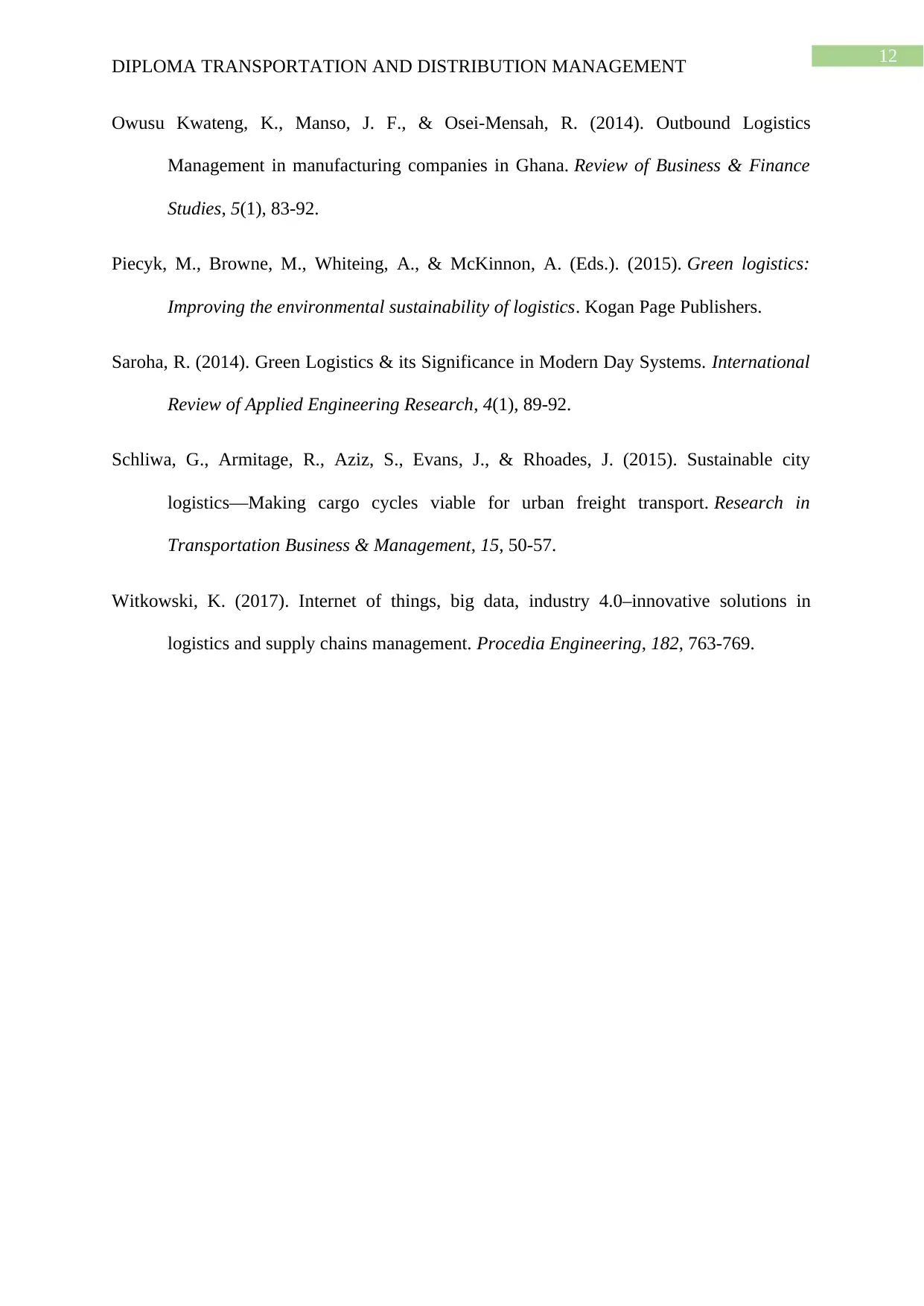
12
DIPLOMA TRANSPORTATION AND DISTRIBUTION MANAGEMENT
Owusu Kwateng, K., Manso, J. F., & Osei-Mensah, R. (2014). Outbound Logistics
Management in manufacturing companies in Ghana. Review of Business & Finance
Studies, 5(1), 83-92.
Piecyk, M., Browne, M., Whiteing, A., & McKinnon, A. (Eds.). (2015). Green logistics:
Improving the environmental sustainability of logistics. Kogan Page Publishers.
Saroha, R. (2014). Green Logistics & its Significance in Modern Day Systems. International
Review of Applied Engineering Research, 4(1), 89-92.
Schliwa, G., Armitage, R., Aziz, S., Evans, J., & Rhoades, J. (2015). Sustainable city
logistics—Making cargo cycles viable for urban freight transport. Research in
Transportation Business & Management, 15, 50-57.
Witkowski, K. (2017). Internet of things, big data, industry 4.0–innovative solutions in
logistics and supply chains management. Procedia Engineering, 182, 763-769.
DIPLOMA TRANSPORTATION AND DISTRIBUTION MANAGEMENT
Owusu Kwateng, K., Manso, J. F., & Osei-Mensah, R. (2014). Outbound Logistics
Management in manufacturing companies in Ghana. Review of Business & Finance
Studies, 5(1), 83-92.
Piecyk, M., Browne, M., Whiteing, A., & McKinnon, A. (Eds.). (2015). Green logistics:
Improving the environmental sustainability of logistics. Kogan Page Publishers.
Saroha, R. (2014). Green Logistics & its Significance in Modern Day Systems. International
Review of Applied Engineering Research, 4(1), 89-92.
Schliwa, G., Armitage, R., Aziz, S., Evans, J., & Rhoades, J. (2015). Sustainable city
logistics—Making cargo cycles viable for urban freight transport. Research in
Transportation Business & Management, 15, 50-57.
Witkowski, K. (2017). Internet of things, big data, industry 4.0–innovative solutions in
logistics and supply chains management. Procedia Engineering, 182, 763-769.
1 out of 13
Related Documents
Your All-in-One AI-Powered Toolkit for Academic Success.
+13062052269
info@desklib.com
Available 24*7 on WhatsApp / Email
![[object Object]](/_next/static/media/star-bottom.7253800d.svg)
Unlock your academic potential
© 2024 | Zucol Services PVT LTD | All rights reserved.





